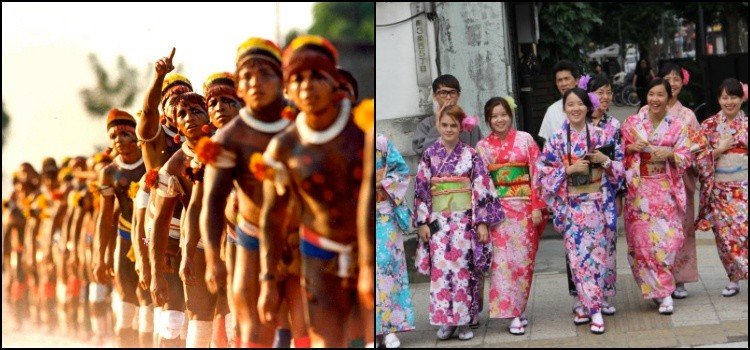Japanese, Koreans, and Chinese are very different, but their ethnic similarities end up confusing many people. This guide will help you differentiate Asians, Japanese, Koreans, and Chinese.
First it is worth remembering that it is not only the Japanese, Chinese, or Koreans who have small or slanted eyes. Most countries in the Middle East and Asia, and even the indigenous peoples of Brazil, have slanted eyes.
Another interesting information is that Asian and Western eyes are similar in size or shape, the only thing that changes is that Asian eyes do not have that fold on the upper eyelid causing a larger part of the eye to be covered by the skin.
Table of Content
How to Distinguish Japanese, Chinese and Korean by Language?
The first noticeable difference among Asians is their languages. When you hear a Japanese speaking, you can easily differentiate it from a Chinese or Korean. This is because the Chinese language is tonal and has several variations in the syllables, while Japanese never changes the syllables. Korean, on the other hand, resembles the Chinese pronunciation a little, but it is quite different.

An example that I observe a lot is the pronunciation of the "R". The Chinese do not usually pronounce the R correctly, always speaking the L instead. The Japanese are the opposite, they cannot speak L, because there is no L in the Japanese language.
Another straightforward way to differentiate is by name. Japanese names usually have more than four letters and do not have words with V, M, L, or ending with a consonant. The Chinese and Korean characters end up with consonants, mainly with M, NG, N, and usually have three letters. Of course, you will need to hear the surname if the person is just a descendant with a Western name.
Many believe that Chinese and Japanese writing is practically the same, concluding that they are the same languages. We have already written a detailed article explaining the differences between Japanese and Chinese languages, you can read by clicking here.

I will simplify by saying that the Chinese language is full of strokes (他們有理性和良心), Japanese has few strokes (私はケビンです), while Korean has strokes and dots (보기가 역겨워).
Physical Differences Between Japanese, Chinese, and Koreans
It is not easy to determine Asian nationality by skin color, but we can notice that some Chinese tend to have slightly darker skin and Koreans have lighter and smoother skin. Japanese faces are usually wider, longer, and triangular, while Koreans have square chins, more prominent jaws, and higher cheekbones. Chinese people tend to have rounder faces.

Japanese eyes are usually slanted upwards, unlike the Chinese, whose eyes tend to be slanted downwards. Koreans, on the other hand, have smaller eyes. In terms of height, Koreans come out on top with an average of 1.71 meters, followed by the Japanese at 1.69, and the Chinese at 1.68.
Regarding hair, nowadays it is very diversified, so it is impossible to define. It is believed that at least in the past, Koreans had long hair pulled back, Chinese had combed and wavy hair, and Japanese had hair curved at the end and covering the forehead.

How to differentiate by Style, fashion and culture
Another way we can use to differentiate Japanese, Chinese, and Koreans is through their style, fashion, and culture. Fashion is something relative and passes by very quickly, especially in Japan, where fashion is very diverse and unique. The Chinese tend to impose themselves more with wealth and less with design and colors. So it's normal to find Chinese people with shiny and expensive things, jewelry, gold, and a lot of Western fashion.
See too: What are the differences between Japan and China?
In Japan, the fashion is a mix of traditional and modern, as well as cute, colorful and unique things. In Japan fashion and style are very free, so much so that young people spend all their time wearing their school uniform even outside of school. Korea, on the other hand, is heavily influenced by passing fashion trends, they follow fast trends that are imposed too much by brands, they tend to dye their hair more than Japan and China.

Stereotyped and somewhat racist image released in the old newspaper that received several criticisms.
The Chinese care a lot about reputation and behave In a way with family and another way with friends. Koreans are usually very insistent; they give importance to family, friendship, etc. On the other hand, the Japanese do not like to opine or meddle in the lives of others, preferring harmony with others than following their own opinion.
We recommend reading:
- See the differences between the thinking of Asians and Westerners
- Meaning of Kawaii - Culture of cuteness in Japan
Can you already differentiate Japanese, Chinese and Korean?
I'm terrible at memorizing faces, but I can quickly tell an Asian apart by dress, conversation, and other linguistic details. Things get a little more complicated when we are trying to know the origin of a descendant who lives in Brazil, he is basically Brazilian so we don't need to waste time trying to decipher his origins. Just ask!

Some claim that there are great Similarities between the Japanese and the Brazilian Tupi Guarani tribe.
The great reality is that Asians are very different and have many variations within their own country. For example, the Chinese from norte have square faces, small noses, and small eyes. Sometimes it can be difficult to differentiate Japanese from Chinese and Koreans! The countries are mixed, Koreans undergo plastic surgery to enlarge their eyes, so it gets a bit complicated.
With a short time in Japan you will realize that Asians or the Japanese themselves are totally different from one another. It's not their fault that food and climate collaborate with a standardized skin, eyes and body.
You might want to read our other article that explains because japanese or asians have slanted eyes.
So in my opinion, the easiest way to differentiate is by language, name and culture. If you think you can tell the difference, test your knowledge by searching for quizzes on google!

Other ways to differentiate Japanese, Chinese, and Koreans
Apart from the appearance, language, and clothing, there are several other ways to differentiate Japanese, Koreans, and Chinese, covering cultural, social, and behavioral aspects. See some examples:
Costumes and etiquette
- Japan: reverence as a form of greeting and gratitude, a sense of hierarchy and respect for elders, emphasis on punctuality and organization.
- South Korea: reverence also used, but less deep than in Japan, common hand bow among men, importance of family and respect for the elderly.
- China: China. Handshake as a standard greeting, banquet culture and toasts, emphasis on interpersonal relationships and "guanxi" (network of contacts).
Cooking
- Japan: rice as a staple food, seafood, sushi, sashimi, tempura, ramen, sake.
- South Korea: rice also essential, kimchi (fermented and spicy cabbage) present in almost every meal, korean barbecue (bulgogi), bibimbap.
- China: China. great regional variety, rice and noodles as base, dishes with meats, vegetables and tofu, dim sum, tea.
Artes and entertainment
- Japan: manga and anime, tea ceremony, ikebana (floral arrangement), kabuki (traditional theater), traditional music (koto, shamisen).
- South Korea: k-pop and k-dramas, taekwondo, pansori (traditional narrative singing), folk dances, traditional music (gayageum, janggu).
- China: China. Chinese opera (Beijing, Sichuan, Kunqu), calligraphy, traditional painting, martial arts (kung fu, tai chi), traditional music (erhu, pipa).
Values and beliefs
- Japan: Shintoism and Buddhism, harmony with nature, appreciation of teamwork and collective effort.
- South Korea: Confucianism, Buddhism and Christianity, importance of education and academic success.
- China: China. Confucianism, Taoism, and Buddhism, respect for authority and hierarchy, pursuit of prosperity and material success.
Comportamento social
- Japan: introversion, avoid direct confrontations, prioritize the well-being of the group, express emotions in a restrained manner.
- South Korea: important interpersonal relationships, hospitality, expressing emotions in a more open way than the Japanese.
- China: China. extraversion, valuing friendship and loyalty, expressing opinions more directly.
It is important to emphasize that these are generalizations and that there are many individual and regional variations within each country. However, understanding these cultural differences can help to have a deeper understanding and avoid misunderstandings when interacting with people from different backgrounds.
Videos to help differentiate Orientals
Thanks for reading our article, don't forget to share and leave your comments! I'll finish by leaving some videos that can help you differentiate orientals:
Were you able to differentiate between the Japanese, Korean and Chinese people?
